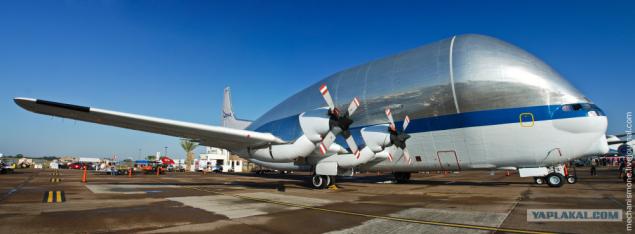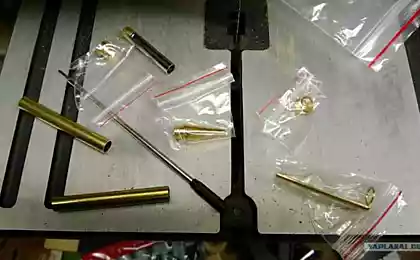929
Super Guppy
One of the world's largest transport aircraft and is perhaps the most unusual and memorable Boeing B-377 Super Guppy.
First took to the skies in September 1962, when all aeronautical engineers and designers have clearly said - this plane will never fly. Despite the unambiguous declarations experts, John Conroy continued creation of a "pregnant" aircraft length of 43 meters and a wingspan of 47 meters, the lifting capacity of 24 tons and a useful volume of the vehicle compartment to 1100 cubic meters.
6 photos.

1. In 1960, NASA launched the program at full capacity "Saturn", but the engineers faced a technical problem - creating rockets, no one thought about the logistics issues. Thus rocket stages had to travel from California to manufacturers by sea via the Panama Canal to Florida and then to the platform assembly. In addition to the weight loss of time (the rocket traveled 18-20 days), often components of steps delivered in a damaged state.

2. John Conroy decided to create a volumetric transport aircraft, and buying written off at the time the Boeing B-377, set to work. The first thing Conroy lengthened fuselage by inserting cut the fuselage with another aircraft. Having made several test flights and making sure that the aircraft in flight feels good, Conroy did superstructure above the fuselage in the form in which we see the plane today. Initially, this was a false superstructure and fixed on the original fuselage only for aerodynamic testing.

3. The first test flight of the "pregnant" aircraft took place September 19, 1962 and after 50 hours of flying with bags loaded with sand, Conroy to prove that such a plane to fly still can. Finally came the latest creation of the aircraft - Conroy had to cut the original fuselage and connect it to the superstructure, as a whole, to get the desired volume of the cargo compartment for transporting rocket stages.

4. When all the work was completed, the cost of an airplane over $ 1 million. Dollars and Conroy began to have serious problems with the financing of the project. At this time, NASA engineers finally believed in that the plane really fly and signed the first contract with Conroy on the delivery of two stages of the program Saturn IV for the period from 28 May to 31 June 1963. Thus was born the Guppy.

5. After a successful delivery, the agency NASA got a new problem. Program Saturn IV-B had larger degree: 12 meters in length and 5 meters in diameter. Conroy is not confused and he began to create a new aircraft that it was decided to call the Super Guppy. But the technical requirements of the Boeing B-377 is not suitable, because the plane was supposed to raise twice as much weight and have a greater volume. It was decided that the fuselage, wings and engines borrow from Boeing C95-J, and leave the cabin of the aircraft B-377.

6. In early 1966 Super Guppy started working for NASA and continues to this day. Of all built Guppy aircraft at number N941NA - the only one that remained in active operation and is currently owned by NASA. All other planes are in museums.
via

First took to the skies in September 1962, when all aeronautical engineers and designers have clearly said - this plane will never fly. Despite the unambiguous declarations experts, John Conroy continued creation of a "pregnant" aircraft length of 43 meters and a wingspan of 47 meters, the lifting capacity of 24 tons and a useful volume of the vehicle compartment to 1100 cubic meters.
6 photos.

1. In 1960, NASA launched the program at full capacity "Saturn", but the engineers faced a technical problem - creating rockets, no one thought about the logistics issues. Thus rocket stages had to travel from California to manufacturers by sea via the Panama Canal to Florida and then to the platform assembly. In addition to the weight loss of time (the rocket traveled 18-20 days), often components of steps delivered in a damaged state.

2. John Conroy decided to create a volumetric transport aircraft, and buying written off at the time the Boeing B-377, set to work. The first thing Conroy lengthened fuselage by inserting cut the fuselage with another aircraft. Having made several test flights and making sure that the aircraft in flight feels good, Conroy did superstructure above the fuselage in the form in which we see the plane today. Initially, this was a false superstructure and fixed on the original fuselage only for aerodynamic testing.

3. The first test flight of the "pregnant" aircraft took place September 19, 1962 and after 50 hours of flying with bags loaded with sand, Conroy to prove that such a plane to fly still can. Finally came the latest creation of the aircraft - Conroy had to cut the original fuselage and connect it to the superstructure, as a whole, to get the desired volume of the cargo compartment for transporting rocket stages.

4. When all the work was completed, the cost of an airplane over $ 1 million. Dollars and Conroy began to have serious problems with the financing of the project. At this time, NASA engineers finally believed in that the plane really fly and signed the first contract with Conroy on the delivery of two stages of the program Saturn IV for the period from 28 May to 31 June 1963. Thus was born the Guppy.

5. After a successful delivery, the agency NASA got a new problem. Program Saturn IV-B had larger degree: 12 meters in length and 5 meters in diameter. Conroy is not confused and he began to create a new aircraft that it was decided to call the Super Guppy. But the technical requirements of the Boeing B-377 is not suitable, because the plane was supposed to raise twice as much weight and have a greater volume. It was decided that the fuselage, wings and engines borrow from Boeing C95-J, and leave the cabin of the aircraft B-377.

6. In early 1966 Super Guppy started working for NASA and continues to this day. Of all built Guppy aircraft at number N941NA - the only one that remained in active operation and is currently owned by NASA. All other planes are in museums.
via
























